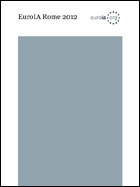“What am I curious about?” - Stephen P. Anderson at EuroIA
I’ve spent the last couple of days at EuroIA in Rome, and I’ve been gradually making my way through publishing all of the notes I made. So far I’ve covered talks by [draws deep breath] Gerry McGovern, Peter J. Bogaards, Birgit Geiberger & Peter Boersma, Raffaella Roviglioni, Jonas Söderström, Andrea Resmini & Eric Reiss, Jim Kalbach & Carola Weller, Hermann Hofstetter & Gregor Urech and Sara Wachter-Boettcher
The conference was rounded off with a closing plenary by Stephen P. Anderson, author of “Seductive Interaction Design”, talking about curiosity.

EuroIA Rome 2012
by Martin Belam
All of my notes from the 2012 EuroIA conference in one ebook, featuring coverage of talks by Gerry McGovern, Peter J. Bogaards, Andrea Resmini, Eric Reiss, Jim Kalbach, Carola Weller, Sara Wachter-Boettcher and Stephen P. Anderson
Available free for iBooks, for Kindle, and as a PDF
“What am I curious about?” - Stephen P. Anderson
I’ll start at the end. Stephen finished his talk with a run through of Walt Disney’s early career. It is easy now to view Disney the company as a schmaltzy over-sentimental juggernaut, who have turned the scarce magic of those early animations into a relentless merchandise and cash-extraction-from-parents machine. Especially if you are a parent.
But Stephen reminded us of Walt himself. A man who tirelessly looked for “the next big thing”, and bet the farm several times on an expensive innovation, whether that was moving to cartoons with synchronised sound, embedding live action inside an animation, or attempting the full length movie of Snow White. It made for a reminder of how often creativity and business innovation can go hand-in-hand if there is the vision to allow it to happen.
Along the way he had shown us a dazzling array of gadgets, gizmos and Kickstarter projects that are the creations of enthusiasts and makers. Highlights included the tattoo that measures your blood sugar level if you are diabetic, or the amazing device from MIT that allows you to sample colours and patterns from the real world and then digitally paint with them. He suggested that the emergence of much cheaper 3D printers, like the Form One, was only going to accelerate the creation of this strata of innovative manufacturing.
He said that being good at UX was fundamentally about being curious. “Tamed problems” like registration and sign in can be solved by design patterns, and become a commodity service. “Wicked problems” need “a curious mind”. Stephen suggested that right now we can charge a lot for UX work and basically be charging for implementing design patterns. But this situation won’t last forever. When he takes on projects, he looks at what makes him curious about the potential work, and what he wants to discover by doing it. That helps him pick the right projects and the right clients.
Stephen’s ultimate message was to ask the crowd what would they like to know more about by the time EuroIA 2013 in Edinburgh rolls around? He mentioned the book “The Medici Effect” by Frans Johansson, which talks about how melding different arts, crafts and sciences together potentially unleashes a new wave of creative ideas as they cross-pollinate. Stephen’s plea was for everyone in the room to ask “What am I curious about?” and then act on the answer.
He said the reason we should be curious is because when we get our qualifications and work in one discipline, the bits‘n’pieces we have to make new ideas are like having Lego bricks of only one size and colour. By gaining Lego bricks of different sizes and colours to work with, we can put together much more varied ideas. He talked about a two-day workshop where geneticists, developers and designers got together to look at different ways of designing and displaying the vast amount of data about human DNA that is collected. The different approaches taken by the devs and the designers meant that by the end of the event, the scientists were discovering new patterns and connections that they had never imagined possible, because the data had been visualised in a different way.
In the end, Stephen said it doesn’t matter what you are curious about - whether it is artisan cheese or medieval literature - the act of being curious will help you be a better UXer.
Next...
I’ve published lots of notes from other people’s talks at EuroIA, but I haven’t yet published the essay version of my talk “Responsive IA: IA in the touchscreen era”. That is up next.
This is one of a series of blog posts about the talks I saw at EuroIA 2012 in Rome. You can download the whole lot in an ebook for iBooks, for Kindle or as a PDF
“The dirty magnet” - Gerry McGovern
“Helping businesses to tackle a ‘wicked problem’” - Peter J. Bogaards
“Process & People” - Birgit Geiberger & Peter Boersma
“An agronomist’s unexpected path to UX Design” - Raffaella Roviglioni
“Responsive IA: IA in the touchscreen era” - Martin Belam
“‘Stupid bloody system!’: Bad IA in the workplace” - Jonas Söderström
“On beauty” - Andrea Resmini & Eric Reiss
“RITE: Testing and a business driver” - Jim Kalbach & Carola Weller
Building a coupon app for iPhone - Hermann Hofstetter & Gregor Urech
“Micro IA and content that travels” - Sara Wachter-Boettcher
“What am I curious about?” - Stephen P. Anderson
You can also download all my notes from the previous EuroIA in Prague as one PDF or as an ePub document.
